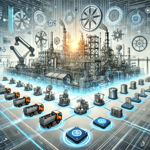 Industrial Internet of Things (IIoT) Engineering has evolved into a macro-discipline that bridges field-level operations with organizational objectives. The IIoT engineer is pivotal in connecting acquisition, preparation, analysis, reaction, automation, and assessment, ensuring seamless integration across devices and systems.
Industrial Internet of Things (IIoT) Engineering has evolved into a macro-discipline that bridges field-level operations with organizational objectives. The IIoT engineer is pivotal in connecting acquisition, preparation, analysis, reaction, automation, and assessment, ensuring seamless integration across devices and systems.
IIoT vs. ML, AI, Big Data, and Edge Computing
The Industrial Internet of Things (IIoT) is often conflated with Machine Learning (ML), Artificial Intelligence (AI), Big Data, and Edge Computing. While these disciplines overlap, they serve distinct purposes:
- IIoT: Focuses on devices and their connectivity to the industrial ecosystem.
- ML and AI: Operate on prepared and verified data to generate insights and predictions.
- Big Data: Refers to the vast volumes of data generated, often by IIoT devices.
- Edge Computing: Involves processing data closer to the source but does not inherently define IIoT devices.
The IIoT industry leverages ML and AI to optimize tasks but does not rely solely on them. Similarly, while edge computing and IIoT often intertwine, they remain distinct in scope and application.
Why IIoT Matters to the Industry
IIoT extends far beyond isolated devices. It integrates data from sensors into actionable insights that enhance operational efficiency, safety, and forecasting. Key considerations include:
- Data Acquisition and Automation: Sensors must not only gather data but enable autonomous monitoring and alerting.
- System Integration: Devices must communicate across networks, creating a cohesive ecosystem.
- Industrial Focus: IIoT centers on industries such as oil and gas, utilities, and manufacturing, differentiating it from consumer-focused IoT applications.
Engineering Skillsets for IIoT Projects
IIoT engineers require a blend of technical and domain-specific expertise. Their responsibilities include:
- Proficiency in Devices: Understanding sensors, actuators, and networked devices.
- Knowledge of Data Management: Calibration, filtering, and ensuring data reliability.
- System Design: Addressing installability, maintainability, and environmental factors.
- Security: Implementing robust measures to safeguard devices and networks.
An effective IIoT engineer bridges multiple disciplines, integrating electrical engineering, data science, and operational knowledge.
Design Methodology for IIoT Projects
Successful IIoT projects follow a structured methodology:
- Define Objectives: Clearly articulate the project’s goals and expected outcomes.
- Iterative Milestones: Break the project into small, demonstrable phases to ensure early wins and stakeholder support.
- Ensure Robustness: Deploy production-ready components with durability and reliability in mind.
- Focus on Usability: Ensure the data presented is actionable and aligns with user needs.
- Plan for Scalability: Design systems that can grow with organizational needs.
Infrastructure Requirements for IIoT Projects
IIoT infrastructure spans multiple domains within an organization:
- Field Operations: Installation, calibration, and maintenance of devices.
- Communication Systems: Reliable networks with failover capabilities.
- Data Retention: Short-term storage for raw data and long-term archives for trends and analytics.
- Analytics: Real-time monitoring, forensic analysis, and predictive modeling.
Closing Thought
 The Discipline of IIoT Engineering demands a unique combination of technical expertise, strategic thinking, and practical execution. As organizations embrace the power of IIoT, the role of the IIoT engineer becomes increasingly vital in bridging the gap between innovation and operational excellence.
The Discipline of IIoT Engineering demands a unique combination of technical expertise, strategic thinking, and practical execution. As organizations embrace the power of IIoT, the role of the IIoT engineer becomes increasingly vital in bridging the gap between innovation and operational excellence.
Blog by Mark Reynolds, updated December 2024.
References
(1) What is the Industrial IoT? [And why the stakes are so high], Jon Gold, Senior Writer, Network World, February 2, 2018
https://www.networkworld.com/article/964912/what-is-the-industrial-internet-of-things-essentials-of-iiot.html


